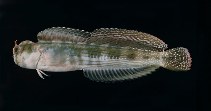| Family: |
Blenniidae (Combtooth blennies), subfamily: Salariinae |
| Max. size: |
16 cm TL (male/unsexed) |
| Environment: |
reef-associated; marine; depth range 0 - 3 m |
| Distribution: |
Western Pacific: Ryukyu Islands southward to McClure and New Year Islands, Northern Territory, Australia. |
| Diagnosis: |
Dorsal spines (total): 12-14; Dorsal soft rays (total): 19-22; Anal spines: 2-2; Anal soft rays: 18-22; Vertebrae: 37-41. Diagnosis: Dorsal fin XII-XIV, 19-22, notched between spinous and segmented-ray portions; anal fin II, 18-22; pectoral rays 13-15 (usually 14); pelvic fin I, 3; caudal fin, procurrent rays 10-14, segmented rays 11-13. Vertebrae 11-12 + 26-29. Orbital cirrus simple filamentous; nasal cirri short and palmate with 2-6 branches; nape without cirri. Lateral line, continuous anterodorsally with simple pores below dorsal spines from 6-7th to 9-10th, disconnected bi-pored series posteroventrally ending below 9th dorsal spine to 1st segmented ray. Mandibular pores 5-7 Lips margin entire. Occipital crest low (up to 2.6 mm) in males, most females only have faint indication of ridge-like crest precursor except greatest specimens which may have a developed ridge up to 0.6 mm (Ref. 559, 9962). Body depth at anal-fin origin 6.8-7.3 in SL. Male body with vertical bars olive brown separated by paler interspaces, and also with dark thin horizontal stripes; also with spots near the tail; preopercular spot dark; dorsal fin spots brown, forming bands. Female with vertical dark H-shaped bars; dorsal fin spotted, caudal fin with 4-5 dark bars (Ref. 48636, 90102). Exhibits geographical color pattern variation (Ref. 9962). |
| Biology: |
Adults occur in intertidal zones in large rock pools or coastal bays (Ref. 48636). Found near-shore (Ref. 9962); common in tide pools (Ref. 559). They feed on algae scraped from rubble or rock surfaces. Sometimes numerous individuals can be seen clinging to rocks out of the water when the level drops on the low of the swell. When disturbed in rock pools during low tide, they may jump out of the water to get to other rock pools or safer deeper water nearby (Ref. 48636). Oviparous. Eggs are demersal and adhesive (Ref. 205), and are attached to the substrate via a filamentous, adhesive pad or pedestal (Ref. 94114). Larvae are planktonic, often found in shallow, coastal waters (Ref. 94114). |
| IUCN Red List Status: |
Least Concern (LC); Date assessed: 24 March 2009 Ref. (130435)
|
| Threat to humans: |
harmless |
| Country info: |
Museum: Batan Is., USNM 139681, 226718, 296035. Babuyan Is., CAS-SU 20650; USNM 317926. Luzon, Cagayan Prov., USNM 309356, 309362. Gubat Bay, USNM 99389. Masbate, Port Cataingan, USNM 99380. Mactan I., USNM 139679, 139682. Maculabo I., USNM 139680. Samar I., CAS-SU 40645. Negros I., CAS-SU 14827 (neotype of Salarias periophthalmus visayanus); USNM 5195 (holotype of S. deani), 51998, 295127 (Ref. 9962). Also Ref. 559, 90102. |
Source and more info: www.fishbase.org. For personal, classroom, and other internal use only. Not for publication.

